
Archaeoprepona demophon, the one-spotted prepona, banded king shoemaker, or demophon shoemaker is a butterfly belonging to the family Nymphalidae.

Nessaea is a genus of nymphalid butterflies found in the Neotropical realm. Unlike virtually all other butterflies with blue coloration, the blue colors in this genus are due to pigmentation [pterobilin ] rather than iridescence.

Morpho amathonte is a Neotropical butterfly belonging to the subfamily Morphinae of the family Nymphalidae. It is considered, by some authors, to be a subspecies of Morpho menelaus.

Mechanitis polymnia, the orange-spotted tiger clearwing or disturbed tigerwing, is a butterfly of the family Nymphalidae. It is found from Mexico to the Amazon rainforest. The wingspan is 65–75 mm (2.6–3.0 in). The larvae feed on Solanum species.

Philaethria dido, the scarce bamboo page or dido longwing, is a butterfly in the family Nymphalidae. It is found in Central America and tropical South America, both east and west of the Andes, from Brazil and Ecuador northwards to Mexico. Strays can sometimes be found in the lower Rio Grande Valley in southern Texas.
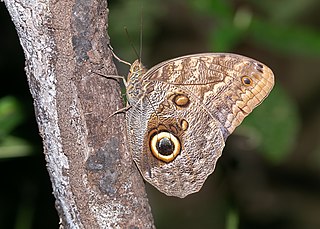
Caligo brasiliensis, the Brazilian owl, sulanus owl, or almond-eyed owl, is a butterfly of the family Nymphalidae. The species can be found in most of South America as various subspecies, including Brazil, Colombia, Venezuela and Ecuador. Its range extends through Trinidad, Honduras, Guatemala and Panama north to Mexico.

Anthanassa frisia, the Cuban crescentspot, Cuban checkerspot or Cuban crescent, is a butterfly of the family Nymphalidae. Subspecies tulcis is known by the common names pale-banded crescent or Tulcis crescent; it is treated as a species by some authors.

Nessaea hewitsonii, the Hewitson's olivewing, is a species of butterfly of the family Nymphalidae. It is common in a broad range of the Amazon basin including the eastern slopes of the Andes mountain range. It is found in high evergreen tropical forest, semi-deciduous tropical forest, and riverine forest.

Nessaea obrinus, the obrina olivewing, is a species of butterfly of the family Nymphalidae. It is found from Colombia and the Guianas to the mouth of the Amazon and south to central Bolivia and Mato Grosso in Brazil, extending to northern Argentina.

Nessaea batesii, the Bates olivewing, is a species of butterfly of the family Nymphalidae. It is found in eastern Venezuela, the Guianas and the lower Amazon in Brazil.

Marpesia is a butterfly genus in the family Nymphalidae. The species of this genus are found in the Neotropical and Nearctic realms.
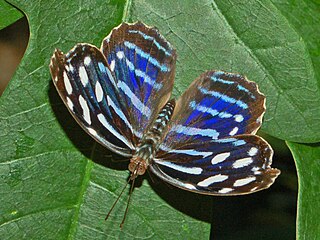
Myscelia cyaniris, the blue wave, blue-banded purplewing, tropical blue wave, whitened bluewing, or royal blue, is a butterfly of the family Nymphalidae.

Prepona laertes, the shaded-blue leafwing or Laertes prepona, is a butterfly of the family Nymphalidae. It is found in large parts of Central and South America.

Tithorea tarricina, the tarricina longwing, variable presonian, or cream-spotted tigerwing, is a species of butterfly belonging to the family Nymphalidae.
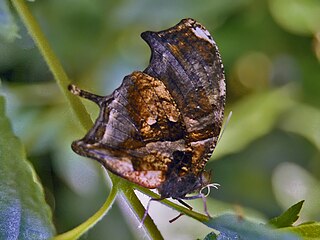
Consul fabius, the tiger leafwing, is the most common and well known species of the genus Consul of subfamily Charaxinae in the brush-footed butterfly family (Nymphalidae). It is found all over the Neotropics.
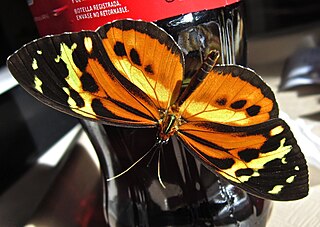
Tithorea harmonia, the Harmonia tiger-wing or Harmonia tiger, is a species of butterfly belonging to the family Nymphalidae.
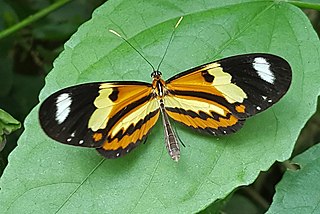
Mechanitis lysimnia, the confused tigerwing, sweet-oil tiger or lysimnia tigerwing, is a species of butterfly of the family Nymphalidae. It was described by Johan Christian Fabricius in 1793. It is found in Central and South America, from southern Mexico to Uruguay. The habitat consists of disturbed forests at altitudes up to 1,500 metres (4,900 ft).

Adelpha erotia, the Erotia sister, is a butterfly of the family Nymphalidae. It was described by William Chapman Hewitson in 1847.

Doxocopa cyane, the Mexican emperor or cyan emperor, is a species of butterfly of the family Nymphalidae.

Hamadryas iphthime, the ringless blue cracker or brownish cracker, is a species of cracker butterfly in the family Nymphalidae. It was first described by Henry Walter Bates in 1864. It is found in Mexico, Central America and parts of northern South America.




















